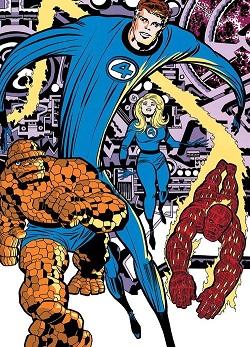
The Fantastic Four is a superhero team appearing in American comic books published by Marvel Comics. The team debuted in The Fantastic Four #1, helping usher in a new level of realism in the medium. It was the first superhero team created by artist/co-plotter Jack Kirby and editor/co-scripter Stan Lee, and through this title the "Marvel method" style of production came into prominence.
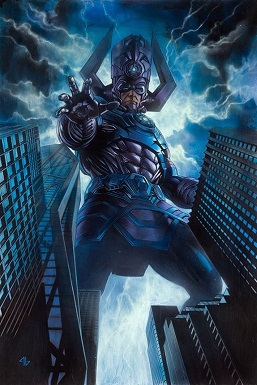
Galactus is a fictional character appearing in American comic books published by Marvel Comics. Formerly a mortal man, he is a cosmic entity who consumes planets to sustain his life force, and serves a functional role in the upkeep of the primary Marvel continuity. He was created by Stan Lee and Jack Kirby and first appeared in Fantastic Four #48.
Marvel Comics is an American comic book publisher and the property of The Walt Disney Company since December 31, 2009, and a subsidiary of Disney Publishing Worldwide since March 2023. Marvel was founded in 1939 by Martin Goodman as Timely Comics, and by 1951 had generally become known as Atlas Comics. The Marvel era began in August 1961 with the launch of The Fantastic Four and other superhero titles created by Stan Lee, Jack Kirby, Steve Ditko, and many others. The Marvel brand, which had been used over the years and decades, was solidified as the company's primary brand.

Spider-Man is a superhero in American comic books published by Marvel Comics. Created by writer-editor Stan Lee and artist Steve Ditko, he first appeared in the anthology comic book Amazing Fantasy #15 in the Silver Age of Comic Books. He has been featured in comic books, television shows, films, video games, novels, and plays.
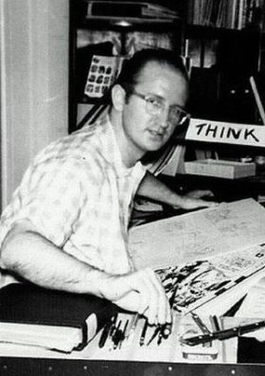
Stephen John Ditko was an American comics artist and writer best known for being the co-creator of Marvel superhero Spider-Man and creator of Doctor Strange. He also made notable contributions to the character of Iron Man, revolutionizing the character's red and yellow design.

Dr. Stephen Vincent Strange is a character appearing in American comic books published by Marvel Comics. Created by Steve Ditko, the character first appeared in Strange Tales #110. Doctor Strange serves as the Sorcerer Supreme, the primary protector of Earth against magical and mystical threats. Strange was introduced during the Silver Age of Comic Books in an attempt to bring a different kind of character and themes of mysticism to Marvel Comics.
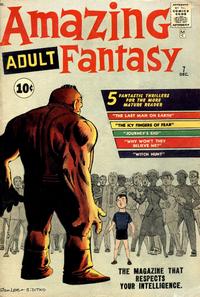
Amazing Adult Fantasy, retitled Amazing Fantasy in its final issue, is an American comic book anthology series published by Marvel Comics from 1961 through 1962, with the latter title revived with superhero features in 1995 and in the 2000s. The final 1960s issue, Amazing Fantasy #15, introduced the popular Marvel superhero Spider-Man. Amazing Adult Fantasy premiered with issue #7, taking over the numbering from Amazing Adventures.
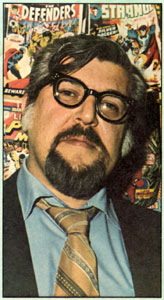
John Buscema was an American comic book artist and one of the mainstays of Marvel Comics during its 1960s and 1970s ascendancy into an industry leader and its subsequent expansion to a major pop-culture conglomerate. His younger brother Sal Buscema is also a comic book artist.
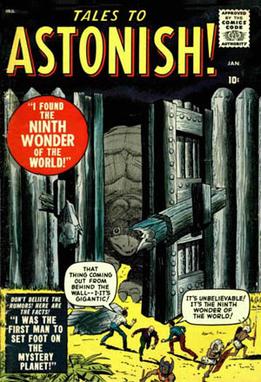
Tales to Astonish is the name of two American comic book series, and a one-shot comic, all published by Marvel Comics.
Strange Tales is a Marvel Comics anthology series. The title was revived in different forms on multiple occasions. Doctor Strange and Nick Fury, Agent of S.H.I.E.L.D. made their debuts in Strange Tales. It was a showcase for the science fiction/suspense stories of artists Jack Kirby and Steve Ditko, and for the groundbreaking work of writer-artist Jim Steranko. Two previous, unrelated magazines also bore that title.

The Fly is a superhero appearing in American comic books published by Red Circle Comics. He was created by Joe Simon as part of Archie's "Archie Adventure Series" and later camped up as part of the company's Mighty Comics line. He first appeared in The Double Life of Private Strong #1 ; however, his origin story and first "full-length" appearance were in Adventures of the Fly #1.
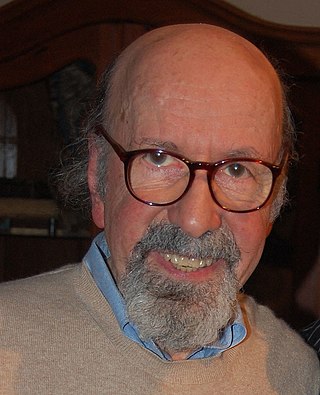
Lawrence D. Lieber is an American comic book writer and artist best known as co-creator of the Marvel Comics superheroes Iron Man, Thor, and Ant-Man. He is also known for his long stint both writing and drawing the Marvel Western Rawhide Kid and for illustrating the newspaper comic strip The Amazing Spider-Man from 1986 to 2018. From 1974 to 1975, he was editor of Atlas/Seaboard Comics. Lieber is the younger brother of the late Marvel Comics writer, editor, and publisher Stan Lee.
The Alley Award was an American annual series of comic book fan awards, first presented in 1962 for comics published in 1961. Officially organized under the aegis of the Academy of Comic Book Arts and Sciences, the award shared close ties with the fanzine Alter Ego magazine. The Alley is the first known comic book fan award.
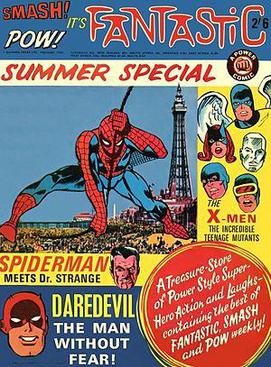
Fantastic was a weekly British comic book magazine published by Odhams Press under the Power Comics imprint. It first appeared on 18 February 1967, and with its 52nd issue on 10 February 1968 it merged with its sister title Terrific. The 89th and final issue of Fantastic appeared on 26 October 1968, after which it was merged into its sister title Smash!.
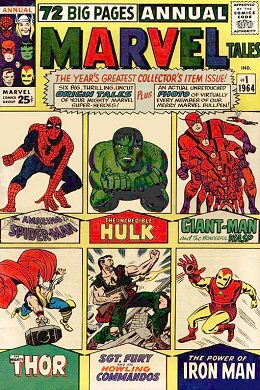
Marvel Tales is the title of an American comic book series published by Marvel Comics from 1964 to 1994 and a flip magazine series published Marvel Comics by from August 2005 to February 2007. Both series primarily reprinted Spider-Man stories.
The Teen Brigade is either of two distinct fictional teams appearing in American comic books published by Marvel Comics. Both teams were recruited by Rick Jones from young amateur radio enthusiasts in order to obtain and divulge strategic information about safety hazards, usually involving the Hulk. These teams were attempting to aid the Hulk in using his super strength for good. They knew he, the Hulk, just desired to help citizens, and did not intend to harm them. The first group was founded in The Incredible Hulk #6. Today, many adolescents are unaware of the Teen Brigade teams. Unless they have access to original comic books, the only Hulk character they may be aware of is in more modern shows or movies.

Jim Salicrup is an American comic book editor, known for his tenures at Marvel Comics and Topps Comics. At Marvel, where he worked for twenty years, he edited books such as The Uncanny X-Men, Fantastic Four, Avengers and various Spider-Man titles. At Topps, he edited books such as Bram Stoker's Dracula, X-Files and Zorro.

Stan Lee was an American comic book writer, editor, publisher and producer. He rose through the ranks of a family-run business called Timely Comics which later became Marvel Comics. He was Marvel's primary creative leader for two decades, expanding from a small publishing house division to a multimedia corporation that dominated the comics and film industries.
Marvel Fireside Books were a series of full-color trade paperbacks featuring Marvel Comics stories and characters co-published by Marvel and the Simon & Schuster division Fireside Books from 1974 to 1979. The first book, 1974's Origins of Marvel Comics, was very successful, and inspired a series of annual sequels.

Fantastic Four is the name of several comic book titles featuring the team the Fantastic Four and published by Marvel Comics, beginning with the original Fantastic Four comic book series which debuted in 1961.















